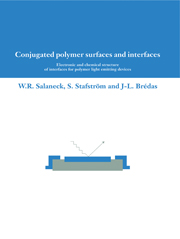 Conjugated Polymer Surfaces and Interfaces
Conjugated Polymer Surfaces and Interfaces Book contents
4 - Materials
Published online by Cambridge University Press: 12 January 2010
Summary
Molecular solids
Molecular solids are composed of discrete units which retain their identities as molecules in the solid phase, for example, when condensed from the gas phase into thin films. Molecular solids may be single crystals, polycrystalline or amorphous in structure. Bonding within the molecules is usually covalent, and is localized to within the molecular units. There are usually no inter-molecular covalent bonds, only weak Van der Waals forces. On the other hand, there are systems which are molecular yet more firmly bound in the solid, e.g., the amino acids and other hydrogen-bonded molecular solids. Hydrogen bonding in the zwitterionic state of condensed molecular solids has been studied by photoelectron spectroscopy, the primary experimental tool used in the results presented in this book.
In chapter 7, all works discussed on model molecular systems for conjugated polymers refer to condensed molecular solid ultra-thin films, generally prepared by condensation of molecules from the effusion of a Knudsen-type cell, in UHV, on to clean metallic substrates held at low temperatures. Clean is defined as atomically clean as determined by core-electron level XPS, such that there is intimate contact between the molecules at the substrate–film interface, without the influence of, for example, a metallic oxide, hydrocarbon or other contamination. In general, non-cross-linked polymers, and linear conjugated polymers in particular, comprise a special case of molecular solids. Exceptions are pointed out, as necessary.
π-Conjugated polymers
In linear polymer molecules which are not conjugated, the electronic structure of the chain of atoms or chemical groups which comprises the backbone of the macromolecule consists of only σ-bands (possibly with localized π-electronic levels).
- Type
- Chapter
- Information
- Conjugated Polymer Surfaces and InterfacesElectronic and Chemical Structure of Interfaces for Polymer Light Emitting Devices, pp. 50 - 63Publisher: Cambridge University PressPrint publication year: 1996
- 1
- Cited by


